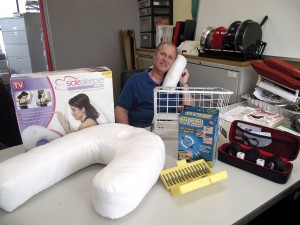
At his Halstead Avenue office across from the Metro-North station in Mamaroneck, Stuart Berger is surrounded by an array of products of inventive ferment. Some seem the stuff of infomercials ”“ $19.95 and $9.95 gadgets that do useful, time-and-finger-saving things.
The objects ”“ odd-shaped pillows, tip-down wire baskets for hard-to-reach shelves, hand drill that cuts the work in half, rifle-length and pistol-sized nail guns, kitchen pot organizer, vegetable safety gripper-slicer, door-gate net for pets, quick amateur sketches and patent-worthy drawings on paper ”“ suggest an entrepreneurial mind in a state of ceaseless invention. That is Stu Berger”™s mind, making marketable matter of his and other inventors”™ practical and problem-solving ideas.
Some inventions, after all the $1,000 prototypes, just don”™t work or are out of price reach for retail consumers. “One out of 10 is a winner,” said Berger, who is more discriminating than some larger invention marketing companies when selecting products and concepts to license. “That”™s the ratio, industrywide.”
At his one-man company, Integrated Merchandise Group International Ltd., “I”™m on the phone every day and night with China,” said Berger, whose prototypes and finished products are manufactured in China. “They”™re 12, 13 hours ahead. It”™s America by day and China by night.”
Berger”™s trade connections with China date to the 1980s, when he designed corporate promotional products that he had made in China and other Asian countries. Those licensed products ”“ now-banned Marlboro-branded sleeping bags and coolers for Philip Morris Co., an Andre Agassi line of Canon EOS Rebel products, a Canon Photura camera bag, Coppertone children”™s products, Bailey”™s Irish Cream ceramic ware ”“ occupy nostalgic pop-culture space on his office shelves.
But profits in that business dried up with the phenomenal growth of email and the Internet, when “Everyone and his brother became an importer,” he said. “We saw the big companies were licensing out stuff to 20 different companies. And needless to say, you couldn”™t make any money.”
Berger was introduced to his new line of international business at an inventors”™ show in Pittsburgh. He began securing product licenses, either directly from inventors or through other invention services companies such as Invent Help.
Inventors typically are paid licensing fees of 1 to 2 percent on products sold by direct response television commercials, or DRTV, and 3 to 4 percent for sales to wholesalers supplying retail stores.
“When I license stuff, there”™s no cost to the inventor,” Berger said. “They”™re finished. Every other gamble is mine.” If he has not developed a marketable product after one year, he usually gives back the license to the inventor so that he or she can seek other opportunities.
Looking at a patented concept, “I have a very good feeling for being able to see products in action, and most people can”™t,” Berger said. That allows him to see potentially profitable new uses and modifications for products that are not what their original inventors had in mind.
Several years ago, Berger licensed a houseware item that peeled potatoes and vegetables. He redesigned it to add a motor. The designer in turn licensed his motorized peeler to Hawthorne-based Allstar Marketing Group L.L.C. Doing business as Allstar Products Group, it is one of the nation”™s largest marketing companies in DRTV.
Berger”™s product did not have the success that a more recent product from Allstar, the Snuggie blanket with sleeves, has had. Unable to lower the gadget”™s cost to reach a reasonable price point for consumers, Allstar decided not to market it.
“Development is not easy,” he said. “I can have a year or more in development. Every time you think that you solved a problem and develop a prototype, you find another problem.” He estimated it costs him from $25,000 to $50,000 in labor and expenses to develop a product.
At his desk Berger played a commercial for The Stray Gate, a removable net barrier that keeps pets from sneaking through open doors. It is priced at $19.95. “I can”™t tell how many prototypes and gyrations I had of that product before I had it to the point where it was ready to go.” His federal patent application for the product is pending.
“For an item to be a successful DRTV item, number one, it”™s Middle America. It”™s got to be a good price point. It”™s got to be demonstrable. It”™s got to be a product that solves a problem that the masses have.”
Sleeping comfortably on your side through the night apparently is a problem for the masses. Berger and an inventive chiropractor have produced a solution.
Berger pulled down a large, oddly shaped cushion from a shelf. It”™s the Side Sleeper Pro pillow and it comes with a well-designed ear rest that helps align one”™s body for pain-free sleep.
“That is my first winner,” Berger said. “I”™ve been in the business five years.”
Since the pillow went on the market a year ago, 1 million pieces have been sold in the U.S. and more than 250,000 pieces in more than 30 foreign countries. Allstar Products has acquired its retail licensing. It is sold at Walmart, Kmart, Bed Bath & Beyond, CVS and Walgreens.
Berger first obtained a license from another invention marketing company, Intromark, for a pillow designed by a chiropractor in Atlanta. “I saw things that made it not sellable,” he said. The pillow was too hard, for one. “If you rolled your head, it would feel like it”™s on a block.” Still, “I saw something in this. I knew there were things I didn”™t like that had to be changed. But I look at concept, not necessarily the item.”
Berger and his partner tested their softer, improved pillow on the QVC television channel. “It sold well and we got numerous reorders,” he said. They developed a short commercial for DRTV and did more media testing before Allstar agreed to take over its retail distribution.
“We got a better deal” on licensing fees from Allstar “because we took more risk” in testing the product, said Berger.
He is developing a smaller side-sleeper pillow for use by air travelers. And he has designed a Side Sleeper Pro version with a bean filling. “My mind is always working,” Berger said.
He pulled out another inventor”™s product, “The Lap Mate,” a support cushion for one”™s laptop. He has designed a smaller version for tablet computers.
Berger studied it, turned it over, placed it on his lap. “I don”™t know exactly what I”™m going to do with it.”
Help for inventors
The U.S. Patent and Trademark Office offers advice and assistance for independent inventors at its website page, http://www.uspto.gov/inventors/independent/index.jsp.




















Hi Stu,
I like this article very much and the verbiage at the end of this note, is what caught my attention the most. This is exactly what sets you apart from the rest and that is you are willing to take the time to figure out the rest of the story for an inventor who has already invested his/her heart and soul into an invention.
I have not met anyone in my last five years of research and development, who was willing to look at the concept and the multiple opportunities so worthy of exploration.
I believe other companies scouting for inventions are shooting themselves in the foot by not being more curious and tenacious about the product offerings and caring only about the quick fix. Sad that America has become a country who needs immediate gratification…sort of takes the fun out of the process and so much is lost in transition long-term.
I always said, “The company who understands what it means for an inventor to take an idea from conception to production, then to marketing, will be very lucky to license my product(s). Also the company who has a vision for the concept, multiple challenges and enormous opportunities available for the universe (every single person domestically and abroad) to enjoy forevermore, especially when the inventor has already been successful in selling thousands single-handedly, is every inventor’s dream.
Finally, since we as inventors have already spent enormous amounts of time and money, it is people like you who can make all of this work. Thank You! 🙂
This is what interests me most about your article:
Looking at a patented concept, “I have a very good feeling for being able to see products in action, and most people can’t,†Berger said. That allows him to see potentially profitable new uses and modifications for products that are not what their original inventors had in mind.
“But I look at concept, not necessarily the item.â€